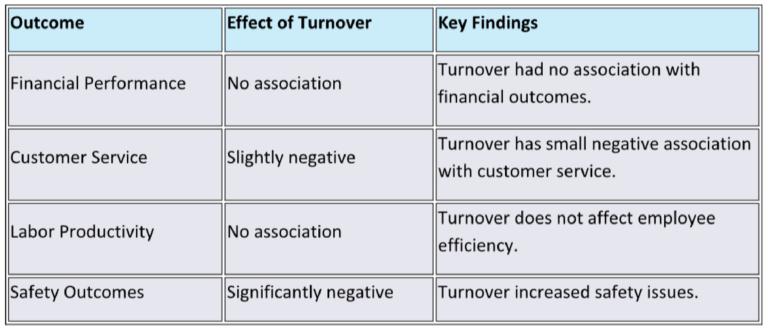The prevailing wisdom imparted to many CEOs is that reducing employee turnover improves firm performance. Many consultants emphasize that lower turnover fosters better customer service, greater financial returns, and stronger organizational stability.
But what if this common belief is flawed?
A comprehensive meta-analysis published in the Journal of Management challenges this assumption, revealing that reducing employee turnover has no consistent effect on employee productivity or firm financial outcomes and only has a modest association with safety metrics and customer service.
These findings raise critical questions about the efficacy of turnover-reduction strategies to boost a firm’s financial performance.

Study
The meta-analytic study analyzed 48 independent datasets comprising over 24,943 observations. Researchers examined relationships between employee turnover rates and four performance outcomes: financial performance, customer service, labor productivity, and safety/quality. Key variables included:
- Turnover rates: Total, voluntary, and involuntary turnover.
- Performance measures: Financial performance, customer service, labor productivity, and safety outcomes.
The researchers employed meta-analytic techniques to assess the association of turnover with financial performance, customer service, employee productivity, and safety outcomes.
What the Study Showed

Key Insights:
- High employee turnover had no measurable association with employee productivity or with financial performance.
- High employee turnover had a modest negative association with customer service
- Safety was the only domain where employee turnover reductions had a strong, tangible benefit.
Key Takeaways
A salient belief that “reducing employee turnover will improve business outcomes” is nothing more than an intuitive leap.
In light of this research, CEOs and senior managers should rethink their excessive focus on employee turnover as a panacea for firm performance.
Some key lessons:
- Are you over-doing employee turnover reduction efforts? Reducing turnover may not translate into improved financial performance or employee productivity.
- Are you in a safety-critical industry? Then turnover’s association with safety justifies targeted interventions to retain employees.
- Prioritize strategic alignment: Instead of broad turnover reduction goals, concentrate efforts on retaining high-value employees in pivotal roles.
- Challenge assumptions: The traditional belief that “less employee turnover is better” oversimplifies the nuanced relationship described here.
CEOs must recognize that employee turnover reduction is not a panacea for improving financial performance. Strategies should be tailored to organizational needs rather than driven by outdated assumptions about the universal benefits of reducing employee churn.
Citation: Hancock, J.I., Allen, D.G., Bosco, F.A., McDaniel, K.R., & Pierce, C.A. (2011). Meta-Analytic Review of Employee Turnover as a Predictor of Firm Performance. Journal of Management, 39(3), 573-603. https://doi.org/10.1177/0149206311424943
